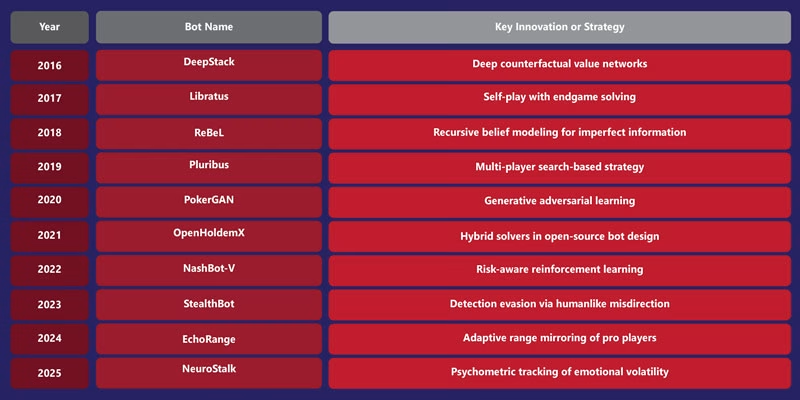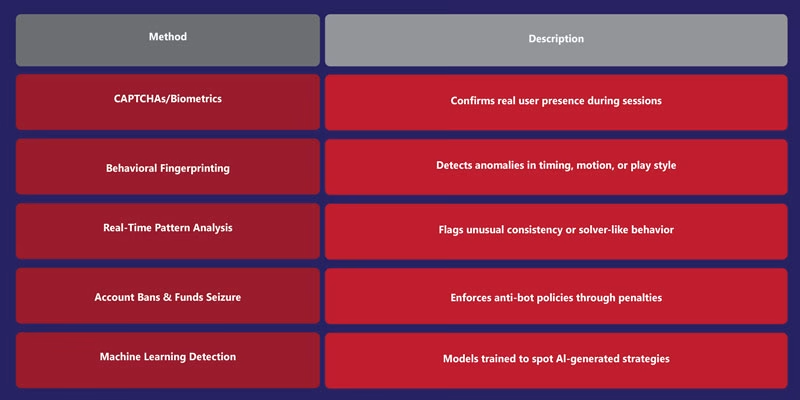Advanced Strategies for Poker Bots: GTO, Neural Networks & Human Behavior! The toolbox utilized behind the scenes expands in tandem with the popularity of online poker. Among the most intriguing and disputed are poker bots, which are computer programs that can play poker at increasing levels of complexity.
Bot design evolved from rule-based scripts to a field that combines complex mathematics, machine learning, and behavioral research. While we explore advanced strategies for poker bots with a focus on neural networks, human behavioral modeling, and Game Theory Optimal (GTO) play, this article also will examine the state-of-the-art in bot design. All are intersections that mark the new frontier for poker bots.
Advanced Strategies for Poker Bots
Unlock the full potential of your poker bot with advanced strategies that integrate Game Theory Optimal (GTO) principles, cutting-edge neural networks, and deep analysis of human behavior. By leveraging GTO, your bot can make mathematically sound decisions in any scenario, while neural networks enhance adaptability through pattern recognition and real-time learning.
Incorporating insights into human psychology and decision-making further refines your bot’s edge, allowing it to exploit non-optimal play and bluff more effectively. Mastering this trio of techniques is essential for building high-performing poker bots that dominate both AI and human opponents in today’s competitive environment.
The Foundation of Bot Strategy in Poker
Static heuristics such as pot odds, tight-aggressive plays, and elementary hand analysis were once employed by early poker bots. In dynamic multi-player games, however, these plays did not stand. Bots had to move from deterministic logic to adaptive strategy as the players did, and that was a demand for change.
Probability theory, hand analysis, and some strategic models form the multi-layered framework upon which poker bots are created. Static principles were adhered to by early bots. Bots need to have computing resilience and adaptive reasoning to play in current advanced poker environments.
This begins with range-based consideration, where every possible move (call, bet, or fold) has an attached range of possible holdings rather than a fixed hand. Solvers build up these plans by simulating millions of runs to obtain equilibrium play.
Most significantly, bots must balance risk and consistency by accounting for short-term volatility and long-term profitability. Other modeling approaches such as neural networks and behavioral modeling are overlaid atop this foundation.
With no understanding of the math basis of poker, even the most advanced machine learning cannot consistently deliver results at higher levels of play.
Decision Trees and Neural Network Usage

Modern poker bots employ a hybrid decision tree and neural network architecture. Decision trees enable a strategy for each action in terms of game state so that bots can build strategic branches (folds, calls, raises) with little error in each decision. Static trees don’t improve, though. It’s at this point that neural networks, and deep reinforcement learning more specifically, have elevated bot intelligence to the next level.
Poker Bots Hybrid Architecture:
- Integrates neural networks and decision trees.
- Plan decision trees based on game state.
- Neural networks, and more specifically deep reinforcement learning, revolutionize bot intelligence.
Artificial intelligence players like DeepStack and Libratus learned poker without pre-programmed rules instead of by programming and adapted their actions on millions of hands. Neural networks carry out feature abstraction, meaning taking gigantic amounts of data like hole cards, betting patterns, or board texture and reducing all that to tight, helpful information.
In contrast to traditional solvers that use precomputed ranges, these models adapt in real-time to surprises. This has the effect of making neural bots outperform GTO-based bots by exploiting weaknesses in human strategy. The use of trees and learning enables bots to deal with uncertainty in a creative and exact manner.
Exploitative vs. GTO Strategies in Poker Bots
Poker bots fall somewhere on a continuum between Game Theory Optimal (GTO) and exploitative play. GTO is an even, unexploitable foundation, mixing bluffs and value bets in a manner to keep opponents from gaining an advantage.
These equilibrium strategies can be built by the likes of PioSOLver software at astronomical computational expense and not typically in a manner that can exploit weaker players. Exploitative bots are there to find and exploit human weaknesses.
Robot opponent profiling categorizes player types and identifies leaks like folding too much to river bets. Others avoid detection and act human-like through imitation learning. Exploitation has two sides of the coin, however: straying from GTO opens others up to a counterattack.
The best bots flip between the two modes dynamically, starting in GTO and later on switching to exploitative lines once statistical trends start to emerge. The strategic benefit of present-day poker AI is captured by this dynamic interaction.
Handling Multi-Table Scenarios
Multi-tabling is a unique challenge to poker bots, including speed, resource control, and consistency in making decisions in different game situations. Humans may have issues with attention span, but bots can deal with parallel processing and scalable models of memory. Sophisticated bots distribute resources between tables while calibrating for tightening of context in novel games, and loosening when patterns are familiar.
Key strategies of most importance are:
- Asynchronous decision queues: Bots use timing windows and expected value effect for queuing high-priority actions.
- State caching: Bots cache recalculable calculations (e.g., range estimation) between similar situations to avoid lag.
- Table-specific profiling: There is an opponent model per table to allow behavior difference.
- Risk-allocation algorithms: Bots handle variance by aggression manipulation based on cumulative stack exposure.
Although with 10 or more tables a bot can offer near-optimal performance without human fatigue by achieving a good balance between accuracy and speed.
Bluffing Algorithms: Can Bots Fake It?

Bluffing, that centuries-old human capability, can now be coded. Contemporary bots exploit game-theoretic equilibrium in order to put in bluffs at some regularity so they will not get exploited. Yet bluffing does also include time manipulation, analysis of board texture, and opposition modeling.
Routines utilize range merging bluffs, board-directed semi-bluffs, and randomness layers in an attempt to trick opponents and hide from being uncovered in the game of poker.
Although bots lack emotions, they bluff more rationally than human beings, based solely on the principles of expected value and deception breakpoints. Some even mimic human hesitation or betting mannerisms to give the illusion of natural behavior. With enhanced detection tools, bluffing bots now have to fool not only players, but sites too.
Adaptive Learning in Modern Bots
We could say this about them that:
- Reinforcement learning allows bots to learn strategies by trying and rewarding.
- Opponent modeling enables bots to modify play according to behavioral tendencies.
- Ongoing feedback loops refine decision weights over time.
- Meta-learning allows bots to improve across formats (e.g., cash, tournaments).
- Human mimicry layers enhance stealth and randomness.
Dealing with Unpredictable Human Behavior
Human players deviate from rational patterns from tilting, or slowing down, to overestimating hands, all of which make optimal-model-trained bots difficult. To counter, sophisticated bots employ probabilistic reasoning and stochastic modeling to adapt to a broad spectrum of irrational play. Rather than relying on consistency, they employ confidence weights to observed behavior and dynamically update opponent profiles.
This allows bots to recognize when a player gears up or acts emotionally, for example, blindingly bluffing suddenly or playing hyper aggressively after losing. In addition, Bayesian updating is used by some systems to refine predictions based on new information throughout the game. Adaptive bots reacting to unpredictability not only protect against exploitation but also gain from human volatility.
In this method, randomness is accessible noise which is a deviation from theoretical equilibrium which master bots can systematically penalize. Even though no AI can perfectly imitate human emotion, world-class systems are rapidly approaching it day by day.
Read More: How to Raise Player Retention & Engagement in 2025: Best White Label Poker Software with CRM!
Timing Tells and Bet-Sizing Patterns
Micro-signals of bet-size small and timing are even capable of indicating player intent when playing online. Micro-signals can be construed by bots and made much stronger. By looking at reaction time, size consistency, and board context, they extrapolate potential hand strength and mindset.
How-to usage tips on such patterns:
- Watch for timing quirks: rapid or plodding action normally indicates strength or weakness.
- Pay attention to bet-size quirks: tight bets draw in, and overbets polarize.
- Compare to population baselines: Find out if a player’s action is according to normal patterns or not.
- Use decoys: Sophisticated bots provide false timing cues that mimic human trackers and detection software.
- Adjust the aggression accordingly: Target weak patterns and harden against evasive ones.
Case Studies of Successful Bot Strategies

A number of high-profile bots have exhibited sophisticated poker strategy at play. Check this out from 2016 to 2025:
These bots did not just defeat humans; they exploited subtle vulnerabilities and rewrote strategic benchmarks. In winning, they proved the scalability of AI from heads-up settings to complex, multi-agent environments.
Programming Custom Strategies into Your Bot
Building a high-performing poker bot is less an issue of generic solvers and more a situation of developing context- and goal-specific solutions for your bot. This typically includes:
- Describing player types your bot will be facing (loose-passive, tight-aggressive) and coding conditional responses.
- Combining solver solutions with hand-specific adjustments (e.g., diverging from equilibrium play versus weak opponents.)
- Creating betting trees specific to game type (cash vs. tournament) and enhancing decision nodes.
- Inserting randomness into action selectors so that predictability cannot exist (e.g., a randomly weighted bluff trigger).
Employing plug-in modules for modules such as ICM (Independent Chip Model) logic in later-stage tournaments. Modern bots exploit modular design by separating perception logic (e.g., hand history interpretation), strategy logic (decision engine), and execution logic (API communication with poker software).
With PyPokerEngine, PokerStove, or custom TensorFlow/Keras-based frameworks, developers can now simulate and optimize thousands of hands per hour to dial in individual styles.
Limitations and Countermeasures by Platforms

Poker bots constantly develop and rise to more defenses such as CAPTCHAs, biometric verifications, tracking mouse moves through behavioral analysis, and discovering bots using AI-based bot identification.
The bots must more closely imitate human weaknesses in order not to be prohibited. The other websites implement adversarial machine learning to explicitly detect evasive AI techniques.
FAQs: Advanced Strategies for Poker Bots
Can poker bots beat professional human players?
Yes. Bots like Libratus and Pluribus have defeated top pros using GTO and adaptive approaches, especially heads-up and six-max.
Can one legally use a poker bot?
It is dependent on a platform. Most of the big sites flat out ban bots and enforce it through detection software. Violations can get one banned and winnings confiscated.
Do robots bluff in poker at all?
Highly sophisticated robots bluff proportionally using probabilistic inference, matching value hands to bluffs in frequency, approximating the randomness of human behavior.
Are bots able to play more than one table concurrently?
Affirmatively. Bots are capable of parallel processing of many decision trees and managing scores of tables with slight error at times, or better accuracy, even, than multitasking human capability.
Is an arbitrary strategy writable for a poker bot?
Yes. Decision trees, learning algorithms, and solvers are used by programmers to design unique strategies for types of players, formats, and goals.


